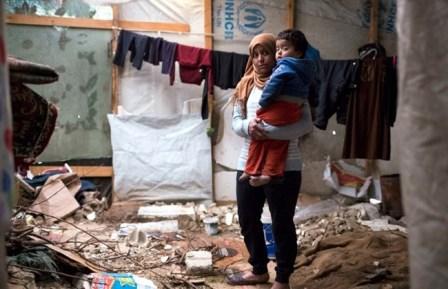
Coughing, 10-year-old Mohammad Ahmad al-Ahmad stood in a cramped, makeshift medical clinic as Dr. Ali Rislan examined him. The boy, from Syria’s Raqqa, had been complaining of chest pain. Friday was the third day NGO Beyond’s emergency medical team had been at Hawsh al-Harimeh 006, a large refugee settlement of around 300 tents in West Bekaa, just a few kilometers from the Syrian border.
Families with children were still lining up, waiting to be seen.
This tent belonged to the sharweesh, the head of the camp, but with so many sick needing care, part of it had been turned into an emergency clinic.
As storm “Oscar” hit Lebanon last week, bringing freezing temperatures, strong winds and heavy rain, refugee communities braced for more misery. The Norwegian Refugee Council warned Wednesday that the impact on refugees “could be most severe in North Lebanon and the Bekaa Valley.”
After days of rain, the West Bekaa, a flat agricultural expanse dotted with small towns, half-finished buildings and refugee tented settlements, was sodden Friday.
The rain had reduced the dirt paths in Hawsh al-Harimeh 006 to mud, and the cold winter air was tinged with the acrid smell of burning plastic as refugees, unable to afford scrap wood to fuel the small stoves to warm their tents, turned to cheaper sources of fuel.
Dr. Melhem Harmouche, who is responsible for Beyond’s health operations, explained that the burning plastic was creating respiratory illnesses such as asthma, bronchitis and pneumonia.
“We have a lot of these [cases] now,” he told The Daily Star from the makeshift clinic. With the severe winter weather, “we have [cases of] jaundice, we have hypothermia, we have temperatures, high temperatures ... we have gastroenteritis, abdominal pain, chest pain, cough, tonsillitis.”
It is mainly children they are seeing, he said, adding that they have transferred two people to hospital in the last three days alone.
Harmouche, who has been working as a doctor with Beyond for five years, said the current health situation in the camp is worse than previous years.
“There’s more infectious disease, more asthma disease, pediatric disease ... [such as] anemia, bronchitis, emetic [vomiting] diseases,” he said.
Abdel-Karim al-Khalaf, 42, is also from Raqqa and his family now lives in a tent a short walk from the clinic, but the path has become a slippery track where the mud is almost ankle-deep in parts.
While some wear wellington boots, one man had simply tied plastic bags over his feet in a bid to keep them dry.
Khalaf said his children have been sick with high temperatures and coughs, but that the water and mud around their tent had been so high the day before, they were unable to reach the emergency clinic.
Pulling off his muddied shoes, Khalaf explained that when it rains, they spend all day just trying to keep the water out of their tent.
Despite their efforts, the floors inside were wet. Piles of damp mattresses and bedding lay around the tent where Khalaf and his wife, 33-year-old Foza Mohammad al-Alo, live with their seven children.
Khalaf touched part of the roof and water came spilling down. They have had to place buckets around the makeshift room because of leaks, but they said the tent is better than one they were living in before.
In a smaller tented settlement in nearby Omariyyeh, 30-year-old Hiba al-Ali from Raqqa held her 2-year-old son Eshak in her arms in the tent where she and her five children have been living for around six months.
This camp has around 20 tents, some housing large families, some containing two families each.
According to the December figures from the U.N. refugee agency, UNHCR, around 360,000 of the just under 1 million Syrian refugees in Lebanon live in the Bekaa Valley.
While in some camps, the polythene canvas tents around a wooden frame are placed on concrete foundations, below Ali’s canvas floor was nothing but wet dirt. The tent was poorly sealed and lay open in parts, and in the rudimentary kitchen area where the family eats and bathes, there was no canvas on the floor at all and no electricity. At nighttime, the room is in darkness.
Ali said that someone gave her a heater to warm the tent, but she doesn’t have any wood to burn, which is why she just feeds plastic into the fire to keep it going.
Temperatures hovered around 3 degrees in West Bekaa Friday morning, and nighttime temperatures drop below zero.
In the camp, a social worker from Beyond was distributing “dignity kits” to women to reinforce the importance of personal hygiene for families, even when the freezing, damp conditions make this difficult.
The NGO has had a number of teams reaching out to refugee communities in the area in recent days, as part of its emergency response to the severe weather.
The dignity kits contain soap, hygiene products for women, clothes – including warm hats for children – and shampoo to treat head lice.
In front of another tent, a small boy holding a hammer stands near his grandmother. He wants to build his own tent so that he can be on his own, she says.
At yet another small camp close by in Saadnayel, Child Protection Coordinator for Zahle with Beyond Layla Assi and her team were distributing emergency items – packets of vitamin- and energy-rich food and warm hats for the children, and bread. A social worker was also there distributing dignity kits.
In this settlement of 25 shelters, the conditions were somewhat better than the other two – all the tents were on concrete bases helping keep them firmer and dryer.
But there too, people were burning plastic to keep warm.
As a light rain fell, Layla and her team went from tent to tent.
The sharweesh of this camp, Khaled Nouwayeem, explained that the major concern right now was heavy snow that could cause the tents to collapse.
A 2017 vulnerability assessment by U.N. agencies found that around 17 percent of the then just over 1 million registered Syrian refugee households in Lebanon were living in improvised shelters in informal tented settlements. The assessment found 38 percent of such shelters in the Bekaa to be in poor condition.
Mahmoud al-Khatib, 44 from Homs, lives with his family, including his daughter and her children. He said they have been in the Saadnayel camp for around five years.
He points up at the condensation on the inside of the canvas roof of their tent. He said that no matter how good the nylon sheeting is, it always collects condensation when it’s warmer inside than outside.
He added that if the wind is strong enough, it can lift the nylon sheeting clean off the tent.
And then, he said, there’s the rats that try to get into the tents at night.
Source: The Daily Star
 FR
FR EN
EN AR
AR








